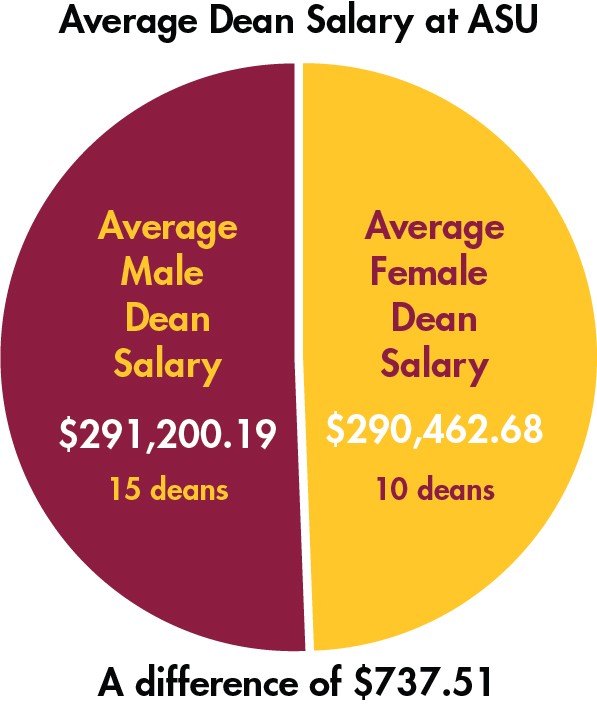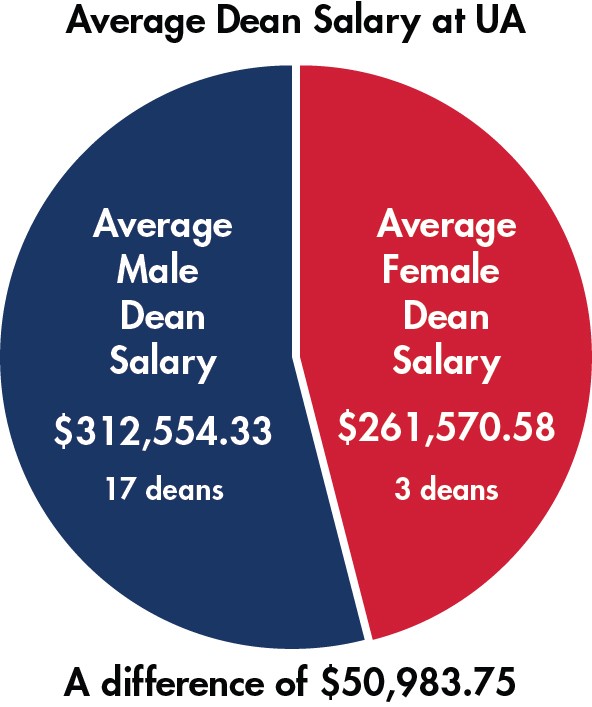Currently, the University of Arizona is putting into place a new compensation infrastructure called the University Career Architecture Project. Compensation regarding fair pay has been under scrutiny at the UA, and there are currently multiple lawsuits against the university for violating the Equal Pay Act in the past two years.
The numbers
According to the 2019 salary report, there are 17 male deans and three female deans, excluding interim deans. There are two female academic deans, Nancy Pollock-Ellwand, Dean of the College of Architecture, Planning & Landscape Architecture and Iman A. Hakim, Dean of the Mel and Enid Zuckerman College of Public Health.
RELATED: University of Arizona 2019 Salary Database
According to the 2019 salary database, excluding interim deans, in 2019 the average female dean salary was $261,570.58. The average male dean salary was $312,554.33 per fiscal year. On average, male deans made $50,983.75 more a year than female deans, excluding interim deans. Not all colleges or positions are equal, making it difficult to examine if there is a gender pay gap.
Arizona State University has 10 female deans with an average salary of $290,462.68 a year; there are 15 male deans with an average salary of $291,200.19. The difference between ASU’s average male and female dean’s salary is $737.51 a year.

The highest paid female dean in the UA 2019 database is Hakim. She made $333,030 and is the eighth highest paid dean. The highest paid dean was Guy Reed, the Dean of the College of Medicine-Phoenix Campus, whose yearly salary was $700,000. The positions are not equal; however, the lack of female deans has raised eyebrows.
“It’s kind of hard to say at this university whether there’s pay inequity,” said Jessica Summers, member of President Robert C. Robbins’ cabinet and chair of faculty. “But that’s a problem in and of itself, right? We should have more women in leadership.”
The university created the Department of Equity, Inclusion & Title IX earlier this semester in an effort to promote equality in school. Ron Wilson, current Title IX Director, is leading the department which deals with incidents of discrimination and harassment; however, they were just established and mostly deal with sexual harassment within athletics, Wilson said.
“Everything about employment, from benefits to salaries to job descriptions to titles is up to H.R.,” Wilson said. Human Resources is in charge of approving pay raises and assigning job titles, positions and salaries.
“I think we could expand our candidate pools quite a bit so that we make sure that we have the best people, including women and people of color,” Summers said.
Summers also said the university has to try hard to change the disparity.
“It’s also hard to attract people to come to campus where everyone is a male dean,” Summers said. “Almost all deans are white, and now we have this lawsuit.”
Recent class-action lawsuits
Fair compensation has been on the radar at the University of Arizona after former Honors College Dean Patricia MacCorquodale filed a $2 million class-action lawsuit against the Arizona Board of Regents in January 2018 for violating the Equal Pay Act.
RELATED: MacCorquodale update: When Title IX goes to court
Former dean of the College of Architecture, Planning, and Landscape Architecture Janice Cervelli joined MacCorquodale’s class-action lawsuit in March 2018, alleging that the university refused to give her any pay raise during her eight years serving as a dean from 2008 to 2016.
After MacCorquodale left her position as dean of the honors college, Elliott Cheu was appointed as interim Honors College Dean. His salary was over $100,000 higher than MacCorquodale’s salary in her final year. Terry Hunt, current Honors College Dean, was being paid $70,000 more annually after she left and was paid $230,000 last year.
Katrina Miranda, a tenured associate professor in chemistry and biochemistry, filed a federal class-action lawsuit against the University of Arizona in November 2018, which claims that the department discriminates against female employees when it comes to pay and promotions.
“Unfortunately, no one at the University of Arizona [can] comment as long as we are engaged in active litigation,” said vice president of UA communications Chris Sigurdson, on behalf of Provost Jeffrey Goldberg.
The initial suit filing from November 29, 2018 stated that female professors are routinely paid less than their male counterparts, and they are denied promotions to professors from assistant and associate professor levels.
According to the UA’s 2018-2019 salary database, there are 38 people in the Chemistry and Biochemistry department that are officially listed as a professor, associate professor or assistant professor. Of those 38, eight are female, and only four of those women hold the title of professor.
“Dr. Miranda has suffered substantial pay disparities as compared to her male counterparts, and the university has failed to promote her in an equivalent manner to these male peers,” the filing said.
The suit filing mentioned three climate surveys distributed to the university at the time: a climate survey in Fall 2016, an Academic Program Review and a Collaborative on Academic Careers in Higher Education survey. All three indicated concerns about gender discrimination and dissatisfaction among female faculty.
The law firm Sanford Heisler Sharp, LLP represents MacCorquodale and Miranda in their class action lawsuits against the university. Andrew Melzer, the New York partner for the law firm, said there is a pattern or trend of unfavorable pay outcomes for women.
“We think there’s a pattern in pay disparities and of holding women back particularly to full professor,” Melzer said. Miranda’s claim against ABOR said she was refused a raise from an associate professor to full professorship despite her clear qualifications.
Sanford Heisler Sharp, LLP often litigates in social justice cases for employees across the nation.
The cases are being investigated thoroughly, paying special attention to the comparison of salaries of female and male deans and professors with similar qualifications.
“We are seeing that in the numbers that have been publicly available, although we will need to obtain more information as the case goes on, and we are also seeing it in the observations and experiences of Dr. Miranda and other women like her,” Melzer said.
The current state of pay at the university
Jan Myers is the director of compensation and the project director of the University Career Architecture Project, UA’s initiative to redesign compensation infrastructure and career architecture.
“We look at where would we collect market data from to help us inform our salary structure, our pay ranges,” Myers said. “We start that by really looking at salary surveys that we either participate in or purchase or a combination of both, and we look at those higher education specific salary surveys.”
UCAP uses the surveys to see how work is organized into job functions or families.
“You might see that we compete nationally for people who run clinical research labs, but we compete locally for marketing and communication, so that changes the salary compensation or competition,” Sigurdson said.
UCAP is currently in the process of calibration, mapping if managers and employee positions match their given titles. Results are currently expected to be shared with employees in October 2019, according to Myers.
“It comes down to we’ve got the position mapped to the right job, the job mapped to the right pay grade,” Myers said. “That helps us analyze and inform where a person should be paid within that pay range based on what they bring – their experience and qualifications – bring to that particular position.”
Myers said that gender is not a factor of the architecture because they do not want “illegitimate factors” to influence how compensation is set and architecture is defined. Once UCAP is complete, Myers said it enables the university to be able to conduct a Pay Equity Study.
“Likely, if anything is a flag through a Pay Equity Study, you’re going to be doing that unique analysis,” Myers said, “but it positions us to have factors that are legitimate factors for variances of pay, to build into a regression model to say, ‘Based on these factors, where would an employee’s expected compensation fall?’”
Follow the Daily Wildcat on Twitter








